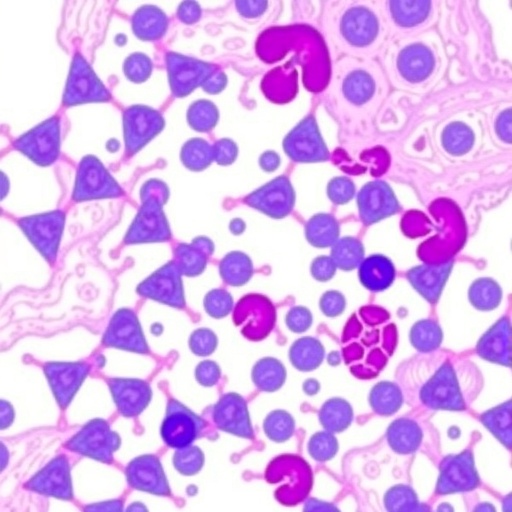In a groundbreaking study poised to reshape the landscape of Parkinson’s disease research, scientists have unveiled intricate profiles of soluble immune factors present in blood and cerebrospinal fluid (CSF) that correlate strongly with mutations in the LRRK2 gene. These findings illuminate potential biological mechanisms underlying Parkinson’s progression and open new avenues for diagnostic and therapeutic innovation. The research, led by Jaffery, Zhao, Ahmed, and colleagues, was recently published in npj Parkinson’s Disease, marking a significant advance in our understanding of neuroimmunology and neurodegeneration.
Parkinson’s disease (PD) is a progressive neurodegenerative disorder characterized primarily by motor dysfunction, stemming from the loss of dopaminergic neurons in the substantia nigra region of the brain. While environmental factors contribute to its etiology, genetic mutations, notably in the LRRK2 (leucine-rich repeat kinase 2) gene, have been identified as prominent risk factors influencing disease onset and severity. Mutations in LRRK2 are among the most common genetic causes of familial Parkinson’s. Until now, the precise immunological ramifications of these mutations remained elusive, hindering targeted therapeutic development.
This latest investigation delves deep into the immunological milieu of both systemic circulation and the central nervous system (CNS) by quantifying a comprehensive panel of soluble immune mediators. Using state-of-the-art multiplex immunoassays, the authors systematically measured cytokines, chemokines, and other soluble factors in blood plasma and CSF obtained from individuals with Parkinson’s harboring pathogenic LRRK2 variants, comparing them to mutation carriers without PD and healthy controls. This robust analytical approach enabled the dissection of subtle yet critical variations in immune signaling.
The study revealed distinctive signatures of immune dysregulation in mutation carriers with Parkinson’s, characterized by elevated levels of pro-inflammatory cytokines such as TNF-α, IL-6, and IFN-γ in both CSF and blood. These molecules are known to exacerbate neuronal injury and amplify neuroinflammation, indicating that systemic and central immune activation might be synergistically contributing to disease progression. Contrastingly, non-manifesting mutation carriers displayed a more subdued immune profile, suggesting that immune perturbations could be a tipping point between genetic predisposition and clinical manifestation.
Moreover, the authors identified alterations in soluble immune checkpoint proteins, which regulate immune tolerance and exhaustion. Dysregulation in these checkpoints within the CNS could impede the resolution of chronic inflammation, fostering a neurotoxic milieu that accelerates neurodegeneration. This novel insight underscores the multifaceted role of immune surveillance disruption in PD pathophysiology, bridging genetic mutations and environment-driven inflammatory cascades.
Extending beyond inflammatory markers, the research team also documented shifts in growth factors and neuroprotective cytokines such as GDNF and BDNF. Paradoxically, these factors were reduced in the CSF of affected individuals, implying a compromised reparative capacity within the CNS. This imbalance between damaging and protective signals may underpin the relentless neuronal loss characteristic of Parkinson’s disease, emphasizing the crucial interplay between immune dysfunction and neuronal survival mechanisms.
Importantly, the authors leveraged advanced bioinformatics to integrate their immunological data with clinical phenotypes, unveiling correlations between soluble factor levels and disease severity metrics including motor scores and cognitive assessments. This correlation places immune factor profiling as a promising biomarker platform, potentially enabling earlier diagnosis, patient stratification, and monitoring of therapeutic responses in future clinical trials.
The translational implications of these findings are profound. By mapping the immune landscape influenced by LRRK2 mutations, the study identifies candidate pathways amenable to pharmacological intervention. For instance, targeting specific pro-inflammatory cytokines with monoclonal antibodies or small molecule inhibitors could attenuate neuroinflammation, possibly slowing disease progression. Concurrently, strategies aimed at boosting neurotrophic factors hold promise for promoting neuronal resilience and repair.
Another captivating aspect of this research lies in its contribution to personalized medicine in Parkinson’s care. The heterogeneity in immune profiles observed among mutation carriers highlights the necessity of tailored therapeutic regimens. Patients exhibiting pronounced inflammatory signatures may benefit most from immunomodulatory approaches, whereas others might require treatments enhancing neuroprotection, anchoring treatment decisions in molecular pathology rather than symptomatic presentation alone.
Mechanistically, LRRK2 is known to modulate immune cell function and neuronal signaling through its kinase activity, thus its mutations may intrinsically alter immune homeostasis. This study substantiates this connection by associating mutant LRRK2 with concrete alterations in soluble immune factors. Understanding how these kinase-driven immune changes orchestrate neurodegeneration could propel the development of kinase inhibitors with dual immunological and neuroprotective effects, a hypothesis currently under exploration in preclinical models.
The study also conducted longitudinal analyses on subsets of participants, offering preliminary insights into how immune factor profiles evolve during early Parkinson’s phases versus advanced stages. Early PD cases exhibited dynamic fluctuations in immune mediator levels, hinting at a therapeutic window where immune modulation might be most efficacious. This temporal dimension accentuates the importance of timely biomarker-guided interventions.
Of note, cerebrospinal fluid analysis provided a uniquely sensitive vantage point into CNS immune dynamics, surpassing peripheral blood metrics in capturing neuroinflammatory processes. Given the invasiveness of lumbar puncture, ongoing efforts are focused on identifying peripheral correlates reliably reflecting central immunity. Success in this arena could democratize immune profiling, facilitating routine clinical application and accelerating the pipeline from bench to bedside.
The authors emphasize that while this study advances the field substantially, further research is needed to clarify causal relationships and to validate immune profiles in larger, more diverse cohorts. Integrating multi-omics modalities and exploring interactions with other PD-linked genes will deepen understanding of the immune landscape in Parkinson’s and reveal broader disease mechanisms.
This research paves the way for a paradigm shift wherein immune factors serve not only as biomarkers but as actionable targets in the fight against Parkinson’s disease. By harnessing the interplay between genetics and immunity, scientists are crafting a future where early detection and precision immune therapies could dramatically alter disease trajectories, offering hope to millions afflicted by this debilitating disorder.
In conclusion, the meticulous profiling of soluble immune mediators in the context of LRRK2 mutations represents a quantum leap forward in Parkinson’s research. The cross-talk uncovered between peripheral and central immune compartments provides a biological blueprint essential for the rational design of next-generation interventions. As these insights permeate clinical practice, they herald an era where Parkinson’s disease is tackled not merely as a neurological affliction but as a complex immunogenetic syndrome amenable to holistic management.
Subject of Research: Soluble immune factor profiles in blood and cerebrospinal fluid associated with LRRK2 mutations and Parkinson’s disease.
Article Title: Soluble immune factor profiles in blood and CSF associated with LRRK2 mutations and Parkinson’s disease.
Article References:
Jaffery, R., Zhao, Y., Ahmed, S. et al. Soluble immune factor profiles in blood and CSF associated with LRRK2 mutations and Parkinson’s disease. npj Parkinsons Dis. (2025). https://doi.org/10.1038/s41531-025-01215-5
Image Credits: AI Generated
Tags: cerebrospinal fluid immune profilesdiagnostic advancements in neurodegenerative diseasesdopaminergic neuron loss in Parkinson’senvironmental and genetic influences on PDgenetic risk factors in Parkinson’simmune factors in blood and CSFLRRK2 gene mutations in Parkinson’smotor dysfunction in Parkinson’s diseaseneuroimmunology and neurodegenerationParkinson’s disease research breakthroughssoluble immune mediators paneltherapeutic innovation for Parkinson’s





